Predictors of self-reported research productivity amongst medical students in the United Kingdom: a national cross-sectional survey | BMC Medical Education
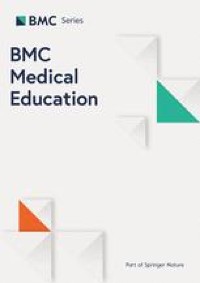
Demographics
At the time of this study, there was 42190 medical students in the UK [24]. We received 1797 responses, of which 154 responses were incomplete and excluded. Qualtrics™ identified 70 responses as duplicates, and these were excluded from our analysis. Of the 1573 valid responses collected, 66.0% (n = 1038) of the respondents were women, 32.5% (n = 512) were men, 1.1% (n = 17) identified as other, and 0.4% (n = 6) preferred not to indicate their gender (Table 1). This contrasts with the population of UK medical students, which comprises of 55% women and 45% men [24]. Most of our respondents were White (n = 798, 50.7%) or Asian (n = 411, 26.1%) (Table 1). Responses were obtained from thirty-six medical schools across the UK. Due to the inability to track the survey distribution, it was not possible to calculate a response rate. However, non-response bias was minimised by ensuring the questionnaire was disseminated through a range of platforms.
PubMed-indexed publications
One hundred and forty-five students (9.2%) had at least one PubMed-indexed publication. Original articles (5%) and systematic review/meta-analyses (2.4%) were the most common publications authored by the respondents (Fig. 1).
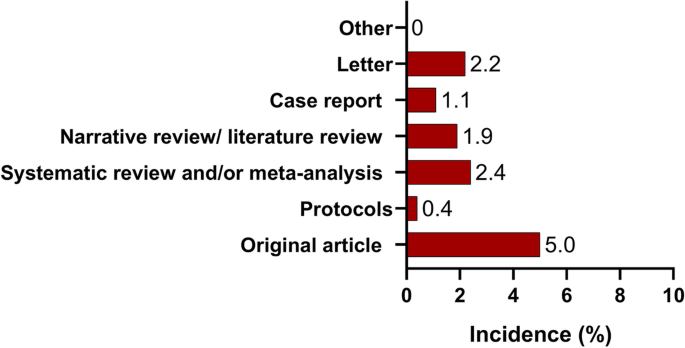
Type of publications authored by the respondents
Multiple regression analysis (Table 1, Fig. 2) indicated that gender (p = 0.032), ethnicity (p < 0.001), the number of research projects conducted by the student (p < 0.001), perception of research (p = 0.038), prior research experience (p = 0.028), and stage of training (p < 0.001) independently influenced the odds of having at least one publication.
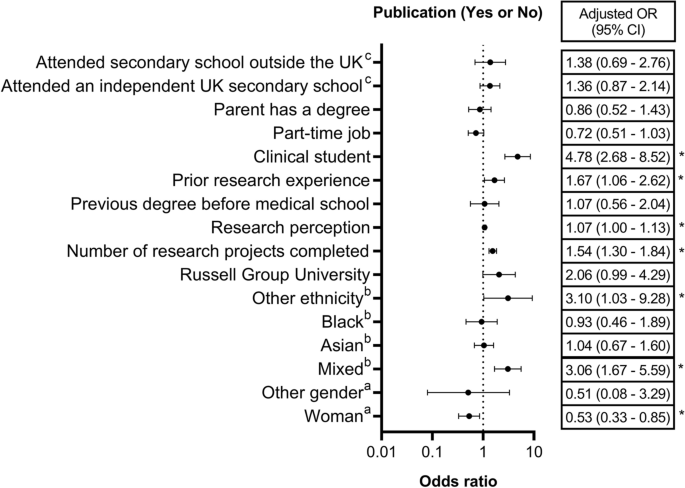
Adjusted odds ratio with 95% confidence interval for being an author on at least one PubMed-indexed article. References: aman; bwhite; cstate school. *: statistically significant
Compared to men, women had a 47% decrease in the odds of having at least one publication (adjusted OR: 0.53, 95% CI: 0.33 – 0.85). Compared to ‘white’ students, ‘mixed ethnicity’ students (adjusted OR: 3.06, 95% CI: 1.67 – 5.59) and ‘other ethnicity’ students (adjusted OR: 3.10, 95% CI: 1.03 – 9.28) had 3.06 times and 3.10 times greater odds of having at least one publication, respectively. There were no statistically significant differences between ‘white’ students and black/Asian ethnicities. Students in their clinical years (‘clinical-years students’) had 4.78 times greater odds of having a publication compared to ‘pre-clinical students’ (OR: 4.78, 95% CI: 2.68 – 8.52).
A higher number of completed research projects unit (adjusted OR: 1.54, 95% CI: 1.30 – 1.84) and a more positive belief in the value of research (adjusted OR: 1.07, 95% CI: 1.00 – 1.13) were associated with 54% and 7% increase, respectively, in the odds of having at least one publication. Students with prior research experience (before medical school) had 1.67 times greater odds of having a publication compared to those without prior experience (adjusted OR: 1.67, 95% CI: 1.06—2.62).
Number of PubMed-indexed publications
Multiple regression analysis (Table 2, Fig. 3) indicated that the number of research projects conducted by the student (p < 0.001) and the student’s perception of research (p = 0.003) independently influenced the number of PubMed-indexed publications authored by the student.
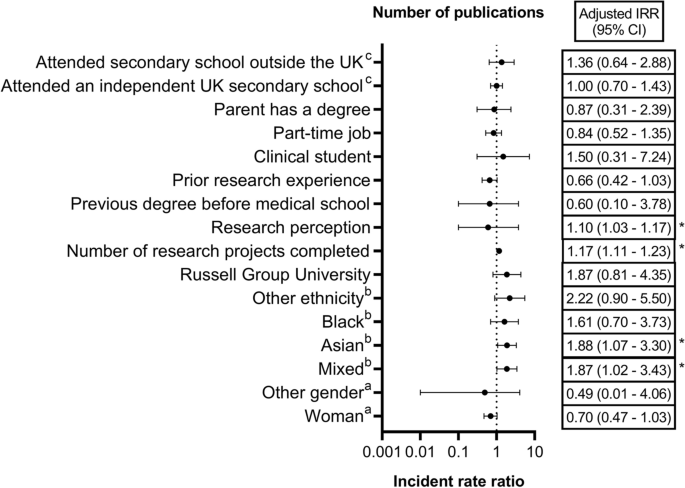
Adjusted incidence rate ratio with 95% confidence interval for the number of PubMed-indexed publications. References: aman; bwhite; cstate school. *: statistically significant
For each additional research project conducted by a student, there were 1.17 times more PubMed-indexed articles published (adjusted IRR: 1.17, 95% CI: 1.11 – 1.23). A unit increase in the student’s perception of research was associated with 1.10 times increase in the rate of publication (adjusted IRR: 1.10, 95% CI: 1.03 – 1.17).
Overall, ethnicity was not a statistically significant predictor of the number of PubMed-indexed publications. However, we demonstrated that mixed-ethnicity students (adjusted IRR: 1.87, 95% CI: 1.02 – 3.43) and Asian students (adjusted IRR: 1.88, 95% CI: 1.07 – 3.30) had a rate 1.87 and 1.88 times greater than white students for the number of PubMed-indexed publications respectively.
Number of first-author PubMed-indexed publications
Multiple regression analysis (Table 3, Fig. 4) indicated that gender (p = 0.020), the number of research projects conducted by the student (p < 0.001), the student’s perception of research (p < 0.001), completing a degree qualification before medical school (p = 0.001), and the type of secondary school attended (p = 0.018) independently influenced the number of first-author PubMed-indexed publications published by the student.

Adjusted incidence rate ratio with 95% confidence interval for the number of first-author PubMed-indexed publications. References: aman; bwhite; cstate school. *: statistically significant
The rate of first-author publications among women was 0.57 times lower compared to men (adjusted IRR: 0.57, 95% CI: 0.37 – 0.89). Compared to the students that attended UK state secondary schools, those that attended independent UK secondary schools had a rate 1.97 times greater for first-author publications (adjusted IRR: 1.97, 95% CI: 1.23—3.15). Compared to other students, those that completed a degree qualification before medical school had a rate 0.30 times lower for first-author publications (adjusted IRR: 0.30, 95% CI: 0.15—0.61).
For every extra research project conducted, students published 1.13 times more first-author PubMed-indexed articles (adjusted IRR: 1.13, 95% CI: 1.08 – 1.19). A unit increase in the student’s research perception was associated with 1.17 times increase in the rate of first-author publications (adjusted IRR: 1.17, 95% CI: 1.09 – 1.26).
National/international presentations
Three hundred and forty-two students (21.7%) had at least one oral/poster presentation at national/international level.
Multiple regression analysis (Table 4, Fig. 5) indicated that ethnicity (p = 0.019), university type (p = 0.024), the number of research projects conducted by the student (p < 0.001), prior research experience (p = 0.025), stage of training, and the type of secondary school attended (p = 0.029) independently influenced the odds of having at least one presentation at national/international level.
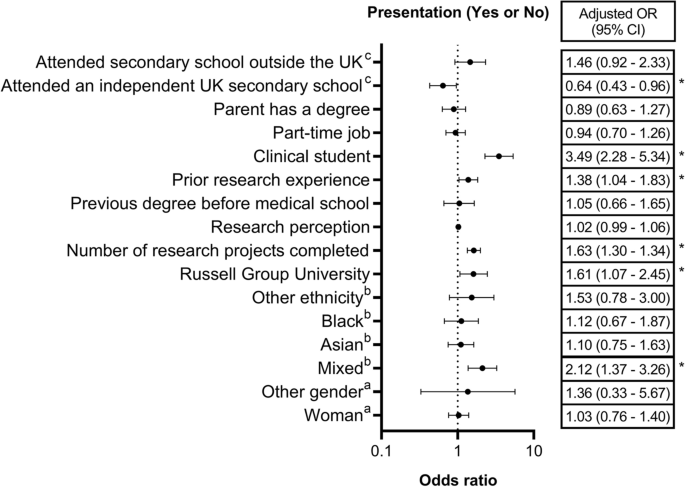
Adjusted odds ratio with 95% confidence interval for having at least one national/ international presentation. References: aman; bwhite; cstate school. *: statistically significant
Compared to ‘white’ students, ‘mixed ethnicity’ students had 2.12 (adjusted OR: 2.12, 95% CI: 1.37 – 3.26) times greater odds of having at least one presentation. There were no statistically significant differences between ‘white’ students and black/Asian/other ethnicity students. Those that attended independent UK secondary schools compared to state UK secondary schools had a 36% decrease in their odds of having at least one presentation (adjusted OR: 0.64, 95% CI: 0.43 – 0.96).
Clinical students had 3.49 times greater odds of having at least one presentation compared to preclinical students (adjusted OR: 3.49, 95% CI: 2.28 – 5.34). Those with prior research experience (adjusted OR: 1.38, 95% CI: 1.04 – 1.83) and the students at Russell Group universities (adjusted OR: 1.61, 95% CI: 1.07 – 2.45) had 1.38 times and 1.61 times greater odds of having a presentation compared to their counterparts, respectively. A unit increase in the number of research projects completed was associated with a 63% increase in the odds of having at least one presentation (adjusted OR: 1.63, 95% CI: 1.34 – 1.99).













